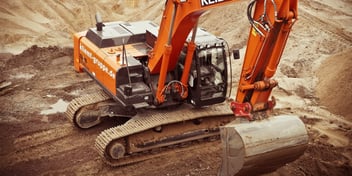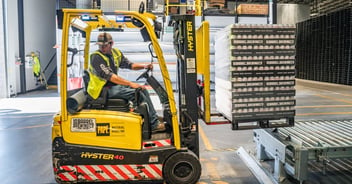If a sheet of paper can cut your finger, imagine what a large machine can do to harm you. Every machine has its own hazards to be wary of, both mechanical and nonmechanical—from papercut sized lacerations to bone fractures and amputations.
Machine guards help to protect operators and nearby employees from sparks, debris, and exposed sharp objects, but machine guarding continues to be included in OSHA’s top ten list of most commonly cited standards violations. These safeguards could help to prevent the estimated 18,000 machinery related injuries each year (source).
One thing that we always stress is the importance of being properly trained on all equipment and safety requirements for the work area. That’s the best way to ensure the safety of the operator and all nearby employees. Understanding how a machine works and how the guards work to protect you results in reduced risk of injury.
According to OSHA standards, “Any machine part, function, or process which may cause injury must be safeguarded. When the operation of a machine or accidental contact with it can injure the operator or others in the vicinity, the hazards must be either controlled or eliminated” (source).
Hazardous Motions and Actions
These are the most common mechanical hazards involved with machines in the workplace:
Hazardous motions: rotating, sliding, and revolving parts
Points of operation: the areas of cutting, punching, bending, shaping, and boring
Pinch and shear points: flywheels, pulleys, belts, chains, couplings, spindles, cams, and gears
Common nonmechanical hazards include flying splinters, chips, or debris that are caused by moving parts; and splashes, sparks, or sprays of any material created from machine operation.
Types of Safeguards
Common safeguards against these hazards include the following measures:
Guards: physical barriers to prevent contact with hazardous parts
Devices: measures in place to limit or prevent access to hazardous areas
Automated feeding and ejecting: limiting operator risk by avoiding physical contact
Location or distance: remove the hazard from the work area when not in use
Miscellaneous aids: shields, handling tools, warning signs
OSHA Requirements for Safeguards
OSHA lists six requirements for machine guarding and operator safety relating to safeguards.
Prevent contact: must provide a physical barrier to prevent hands, arms, or any body parts from coming into contact with the machine’s moving parts.
Secure: must be durable and secure in order to function effectively. Any safeguard that can be easily removed or worn out is not an effective safeguard.
Protect from falling objects: must prevent any objects from falling into the machine.
Create no new hazards: must be an effective safeguard that does not create a new hazard with sharp edges or any other risk of injury.
Create no interference: must not prohibit the worker from performing the task in a timely and comfortable manner.
Allow safe lubrication: should not need to be removed for lubrication of machine parts if possible.
As you can see, there are many different types of hazards and nearly as many safeguards and standards to prevent them. Being aware of these types of safety concerns and the corresponding measures is vital to maintaining a safe work environment for all employees.
Check out our training content covering machine guarding and operator safety! It provides more in-depth coverage for your employee safety training.






Leave a Comment